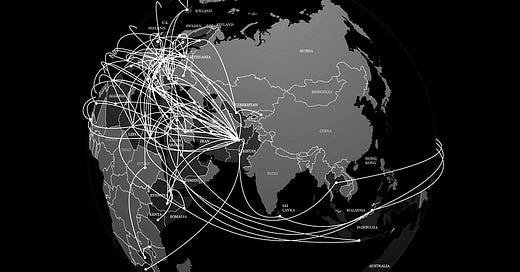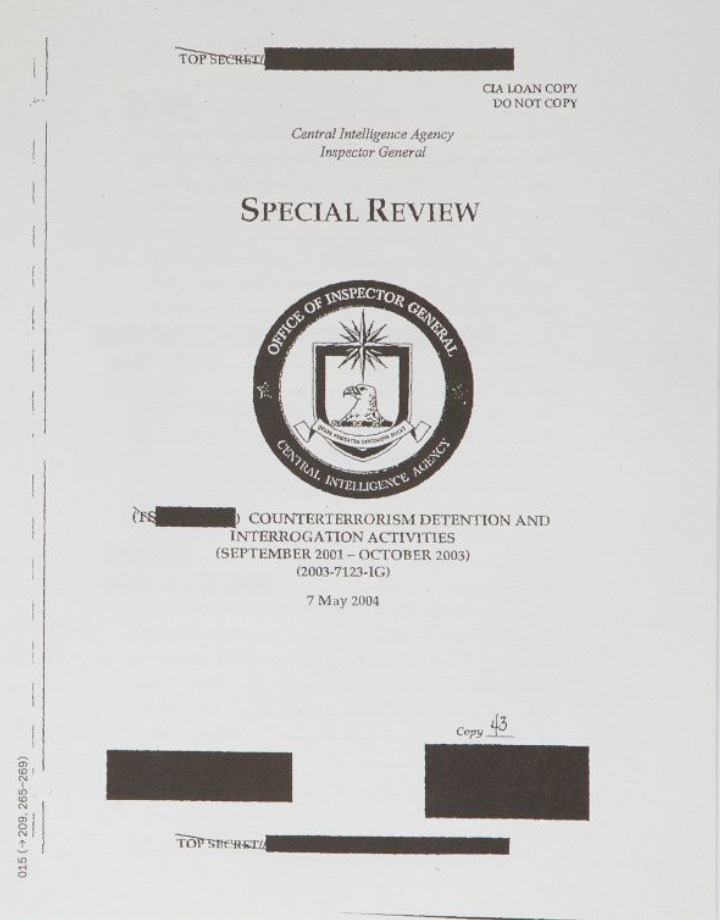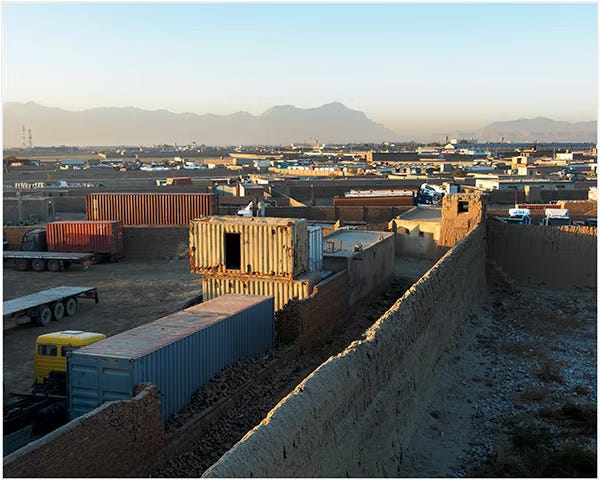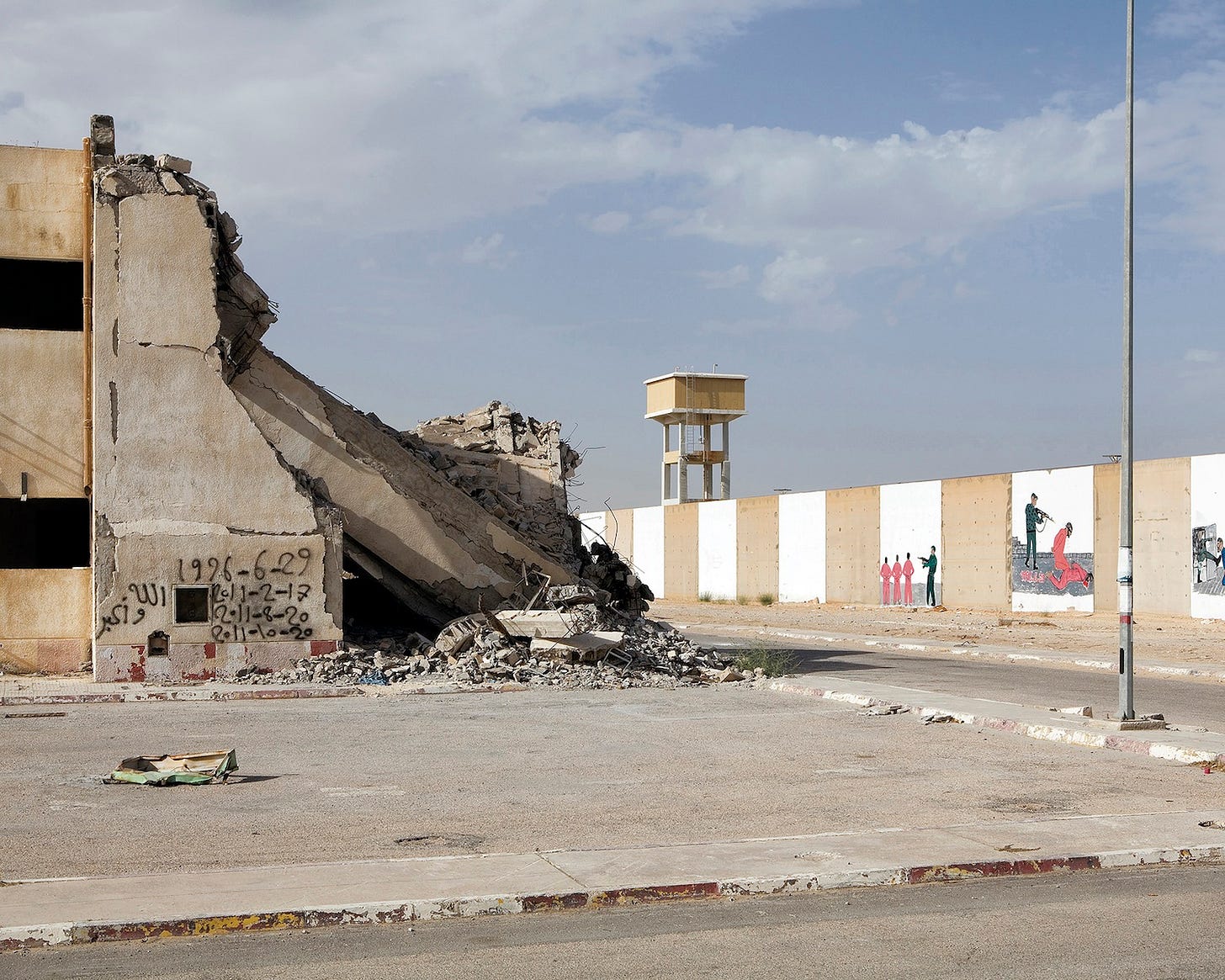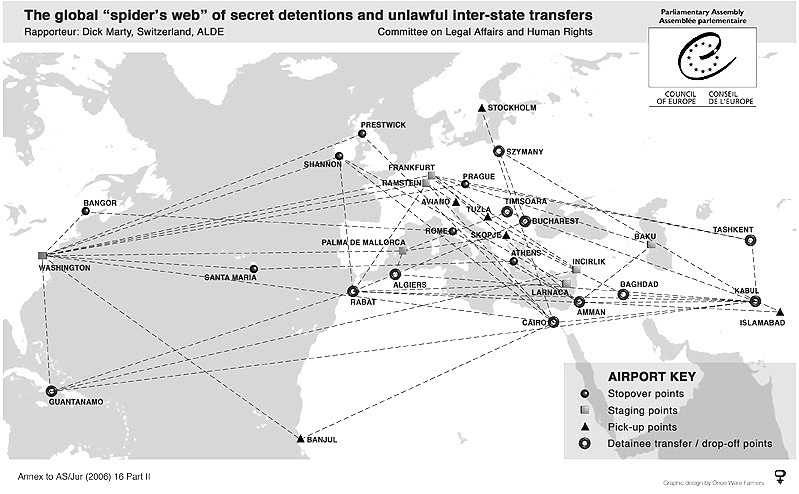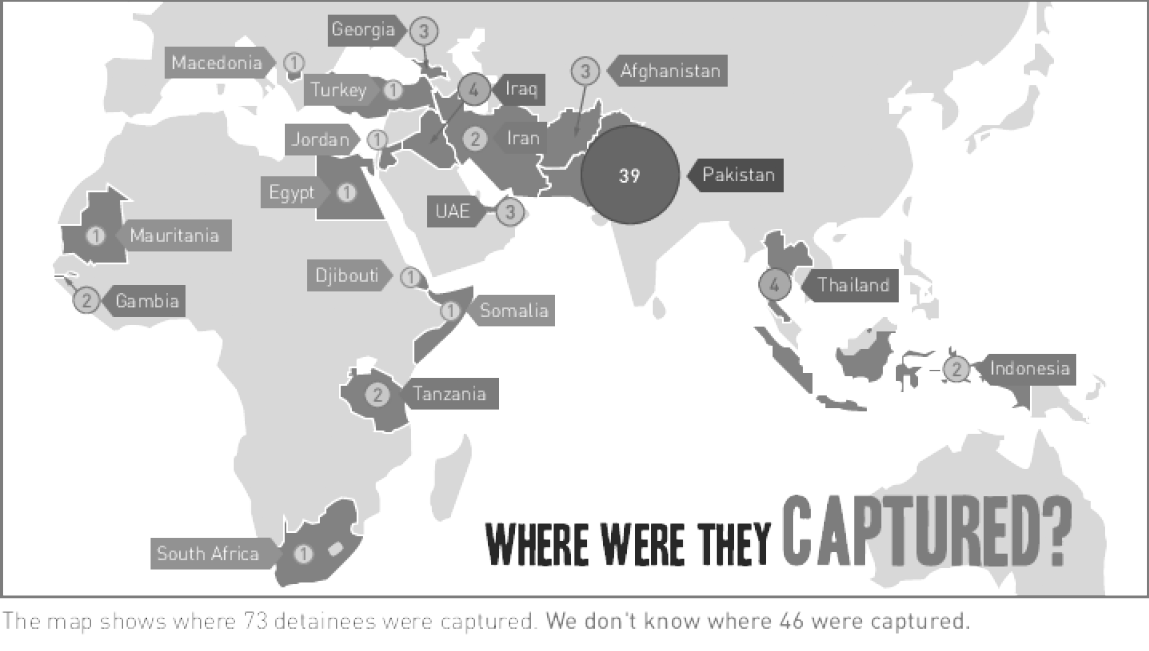Bottom Line Up Front (BLUF)
Extraordinary rendition operations constitute a global extrajudicial detention and interrogation program conducted primarily by U.S. intelligence services from 1993-2005+, involving 54+ (+15) countries, affecting 150+ individuals post-9/11, and utilizing over 100 detention facilities worldwide including multiple undeclared black sites. Operations systematically circumvent legal frameworks through compartmentalized programs, foreign partnerships, and executive authorities.
Ongoing: Beginning with Clinton and expanded under Bush Jr September 17, 2001, covert action MON granting CIA authority to covertly capture and detain individuals. Obama's 2009 Executive Order closing some high profile black sites while continuing renditions to third countries under "diplomatic assurances" (e.g., 2011 Somalia operations). Trump's 2017 reinstatement of CIA black site authority.
OPERATIONAL DEFINITIONS
Extraordinary Rendition: Extrajudicial process involving apprehension and transfer of individuals without formal legal proceedings, bypassing judicial approval and adherence to legal treaties, conducted without court involvement or judicial oversight.
Black Sites: Secret detention facilities operated by intelligence agencies on foreign soil, designed to hold detainees outside judicial oversight.
Ghost Detainees: Individuals held incommunicado without acknowledgment of detention, denying access to legal counsel, families, or humanitarian organizations.
Enhanced Interrogation Techniques (EITs): Authorized interrogation methods including waterboarding, stress positions, sleep deprivation, and hypothermia.
GREYSTONE (GST): Secret codeword for Sensitive Compartmented Information compartment containing rendition, interrogation and counter-terrorism program information, with sub-compartments (e.g., GST-001) providing limited access.



PROGRAM EVOLUTION AND AUTHORIZATION
Clinton Era Origins (1993-2001)
1993: First rendition proposed; White House Counsel Lloyd Cutler identified operation as violation of international law
1995: Presidential Directive 39 authorized renditions to countries including Egypt
Vice President Gore assessment: "That's a no-brainer. Of course it's a violation of international law, that's why it's a covert action. The guy is a terrorist. Go grab his ass."
1995: American agents proposed program to Egypt with global tracking, capture, and transport capabilities including small aircraft fleet
CIA veteran Michael Scheuer confirmation: No torture assurances obtained from recipient nations
Pre-9/11 Egyptian Cooperation
Tal'at Fu'ad Qasim Case:
Presidential Directive 39 approval and CIA selection of Egypt as destination
Egyptian Mukhabarat cooperation established
Template for subsequent operations
Program Assessment (Michael Scheuer):
"What was clever was that some of the senior people in Al Qaeda were Egyptian"
"It served American purposes to get these people arrested, and Egyptian purposes to get these people back, where they could be interrogated"
Mutual benefit arrangement between U.S. and Egyptian intelligence services
Post-9/11 Expansion
September 17, 2001: Classified presidential directive authorizing CIA secret detention and interrogation (remains undisclosed to Congress/public)
2002-2005: DOJ memos authorized EITs including waterboarding, stress positions, sleep deprivation, hypothermia
Operational assessment: "The rendered fighters delivered to Middle Eastern governments are now either dead or in places from which they cannot harm America. Mission accomplished."
OPERATIONAL SCALE AND METRICS
Global Participation
54 participating countries identified:
1. Afghanistan 2. Albania 3. Algeria 4. Australia 5. Austria 6. Azerbaijan 7. Belgium 8. Bosnia-Herzegovina 9. Canada 10. Croatia 11. Cyprus 12. Czech Republic 13. Denmark 14. Djibouti 15. Egypt 16. Ethiopia 17. Finland 18. Gambia 19. Georgia 20. Germany 21. Greece 22. Hong Kong 23. Iceland 24. Indonesia 25. Iran 26. Ireland 27. Italy 28. Jordan 29. Kenya 30. Libya 31. Lithuania 32. Macedonia 33. Malawi 34. Malaysia 35. Mauritania 36. Morocco 37. Pakistan 38. Poland 39. Portugal 40. Romania 41. Saudi Arabia 42. Somalia 43. South Africa 44. Spain 45. Sri Lanka 46. Sweden 47. Syria 48. Thailand 49. Turkey 50. United Arab Emirates 51. United Kingdom 52. Uzbekistan 53. Yemen 54. Zimbabwe
Additional countries
55. Brazil, 56. Dominican Republic, 57. France, 58. Jamaica, 59. Japan, 60. Kazakhstan, 61. Kuwait, 62. Malta, 63. Norway, 64. Qatar, 65. Senegal, 66. Seychelles, 67. South Korea, 68. Tajikistan and 69. Tunisia.
Detention Infrastructure
Over 100 estimated facilities total
50+ prisons spanning 28 countries
25+ additional prisons in Afghanistan
20+ prisons in Iraq
17+ ships as floating prisons since 2001
Funding: Estimated $80M/year for black sites (per Senate report) and $300M+ for flight logistics.
Transportation Network
1,245+ CIA flights documented across Europe
728 prisoners flown through Portuguese airspace
150 CIA flights identified in Portugal (2001-2005)
85 takeoffs/landings at German bases
Contractors: rendition programs are largely carried out using private contractors and leased equipment. Boeing Jeppesen handling logistical planning, Mitchell Jessen & Associates (EIT architects) or Aero Contractors as well as DynCorp, CACI, and Titan Corp involvement in interrogations/transports
NATO facilitation: Blanket overflight clearances provided by Lord George Robertson agreement for "military flights related to operations against terrorism"
Target Population
150+ individuals rendered post-9/11
136+ confirmed victims of extraordinary rendition
Pakistani nexus: Majority of detainees (9 of 14 HVTs) captured in joint U.S.-Pakistan operations
BLACK SITE LOCATIONS AND OPERATIONS
Confirmed Facilities by Region
Afghanistan:
"Salt Pit" (abandoned brickmaking factory outside Kabul)
"Dark Prison" (near Kabul)
Bagram Air Base prison
Jalalabad (suspected)
Asadabad (suspected)
"COBALT" (long-term indefinite detention)
Cuba
Detention site MAROON and INDIGO
Thailand:
First CIA black site established post-9/11
Udorn Royal Thai Air Force Base
"Detention Site Green" (confirmed by senior Thai security official 2018)
Described as "test case" for enhanced interrogation techniques
Poland:
Szymany Airport (confirmed by The Guardian 2009)
Olsztyn-Mazury Airport
Stare Kiejkuty detention site BLUE
Housing for high-value detainees including Khalid Sheikh Mohammed
Romania:
Housing for high-value detainees in Bucharest detention site BLACK in basement of government building
Lithuania:
Detention center VIOLET in Vilnius
Europe (Additional):
Camp Eagle, Bosnia (The Guardian 2009)
Camp Bondsteel, Kosovo (The Guardian 2009)
Middle East/North Africa:
Iraq: Abu Ghraib disclosed as black site
Temara interrogation centre (8km outside Rabat, Morocco)
Abu Zubaydah
Abd al-Rahim al-Nashiri
Ramzi bin al-Shibh
Ion Sheikh al-Libi
Mustafa al-Hawsawi
Sites in Egypt, Libya, Morocco confirmed
Djibouti operations
Diego Garcia:
U.S. Naval Base reported as black site (UK/U.S. officials initially suppressed reports)
Maritime Operations (Floating Prisons):
USS Bataan (temporary initial interrogation site)
USS Peleliu
USS Ashland (stationed off Somalia 2007, concern for 100+ East African captives)
USNS vessels: Stockham, Watson, Watkins, Sisler, Charlton, Pomeroy, Red Cloud, Soderman, Dahl
MV vessels: PFC William B. Baugh, Alex Bonnyman, Franklin J Phillips, Louis J Huage Jr, James Anderson Jr
Other Regions:
UAE: Secret prisons in Yemen with forced disappearances and torture
China: Widespread black sites/"black jails" with alleged Dubai facility
Egypt: Extensive black site usage by security services
Iran: Black site torture increase during Mahsa Amini protests (2023)
Israel: Former Camp 1391 ("Israeli Guantanamo")
Russia/Chechnya: Over 100 tortured, some killed
OPERATIONAL METHODOLOGY
Target Acquisition and Apprehension
Operational Settings:
Public spaces (streets, airports)
Private residences
Transit points/border crossings
Ports of entry
Team Composition:
5-15 operatives typically involved
Historical precedent: Eichmann operation (12 agents), Abu Omar operation (26 Americans)
Teams dressed head-to-toe in black including masks
Apprehension Procedure:
No warrants or legal proceedings required
Targets blindfolded, clothes cut off
Often administration of enemas and sedatives and other compounds
Outfitted with diapers and jumpsuits
Covert negotiations with host security services bypass formal extradition treaties
Transportation Protocols
Pre-transport Processing:
Sedation with sleeping drugs
Enema administration
Diaper and jumpsuit fitting
Complete disorientation procedures
Flight Operations:
Day-long trips common
Civilian aircraft with falsified flight plans (Boeing Business Jet N313P, N379P, N829MG, including Gulfstream III/IV jets)
Destinations: Middle East/Central Asia detention facilities or CIA black sites
Intelligence Collection Systems
CRISSCROSS/PROTON Database:
Metadata storage for phone calls
Location data compilation
Personal information archives
Integral to CIA rendition program for tracking and identification
Collection Methods:
HUMINT: Informants, surveillance, interrogations
SIGINT: Communications intercept capabilities
Pattern-of-life analysis for target monitoring and vulnerability assessment
Intelligence sharing with allied nations for suspect identification and location
Routine monitoring to create behavioral patterns
Multi-source intelligence fusion for operational planning
DETENTION AND INTERROGATION
Facility Classification System
Initial Debriefing Sites:
Thailand, Poland facilities for EIT application
"Test case" environments for technique development
Long-term Holding Sites:
Afghanistan "Cobalt" facility for indefinite detention
Compartmentalized access with GREYSTONE classification
Enhanced Interrogation Techniques (EITs)
Authorized Methods:
Waterboarding
Stress positions
Sleep deprivation
Hypothermia
Extended isolation
Legal Framework:
DOJ memos (2002-2005) provided authorization
Later techniques rescinded/modified
Classification as "illegal combatants" (Bybee/Yoo memos) to exclude standard torture definitions
HIGH-VALUE TARGET CASE STUDIES
Khalid Sheikh Mohammed
Location: Poland black site
Treatment: Waterboarded 183 times
Intelligence yield: Heathrow bomb plot information
Classification: High-Value Target (HVT)
Abu Zubaydah
Capture: Pakistan 2002
Treatment: Extensive waterboarding at multiple CIA black sites
Intelligence assessment: FBI stated rapport-building yielded superior intelligence compared to EITs
Legal finding: UN Working Group on Arbitrary Detention found joint responsibility across U.S., UK, Thailand, Poland, Morocco, Lithuania, Afghanistan for ongoing arbitrary detention without charge/trial
Ibn al-Shaykh al-Libi
Capture: Afghanistan 2001
Rendition: Transferred to Egypt
Intelligence impact: Fabricated Iraq-Al Qaeda WMD intelligence under torture
Strategic consequence: Information used to justify 2003 Iraq invasion
Outcome: Died in Libyan prison under suspicious circumstances
Khaled El-Masri
Status: German citizen
Incident: Mistakenly abducted Macedonia 2003 (name confusion)
Detention: Afghanistan black site with harsh conditions
Legal resolution: European Court of Human Rights ruled Macedonia violated rights, awarded €60,000 compensation (2012)
Duration: Months of detention before release
Gul Rahman
Outcome: Died of hypothermia at Salt Pit facility (2002)
Significance: Documented fatality in CIA custody
Fatima Bouchar
Status: 4.5 months pregnant during detention
Treatment: Chained without food for 5 days in Bangkok facility
Significance: Demonstrates treatment of pregnant detainees
Mohamed Farag Bashmilah
Nationality: Yemeni
Arrest: Jordan 2003, handed to CIA
Detention: Secret prisons including Afghanistan facilities
Outcome: Released without charges 2005
Significance: Highlights black site usage and lack of legal recourse
Ahmed Agiza and Mohammed al-Zery
Status: Egyptian nationals seeking asylum in Sweden
Operation: Deported 2001 to Egypt with CIA involvement
Treatment: Tortured in Egypt
Resolution: Sweden provided eventual compensation
Maher Arar
Nationality: Canadian engineer
Incident: Detained during New York layover 2002
Rendition: Transferred to Syria
Treatment: Imprisoned and tortured over 10 months
Resolution: Canadian commission cleared of terrorism links, formal government apology and compensation
Abu Omar (Hassan Mustafa Osama Nasr)
Status: Egyptian cleric, Milan resident
Operation: Abducted 2003 by 22 CIA operatives in Milan
Rendition: Transferred to Egypt for torture
Legal consequence: Italian courts convicted 23 U.S. and Italian agents in absentia
CIA cooperation: Operation conducted with Italian intelligence (SISMI) cooperation but without official government sanction
Binyam Mohamed
Status: UK resident
Capture: Pakistan 2002
Rendition route: Morocco (severe torture) → Afghanistan → Guantánamo Bay
Release: 2009
Resolution: UK government acknowledged complicity, provided compensation
Mamdouh Habib
Nationality: Australian citizen
Capture: Pakistan 2001
Rendition: Egypt (torture) → Guantánamo Bay
Release: 2005
Resolution: Australian government lawsuit settlement
Ramzi bin al-Shibh
Role: September 11 attacks key facilitator
Capture: Pakistan 2002 (joint CIA-Pakistani operation)
Detention: CIA black site → Guantánamo Bay
Significance: Major operational blow to Al-Qaeda capabilities
INTERNATIONAL PRECEDENTS AND COMPARATIVE OPERATIONS
Historical Context
Argentina "Death Flights" (1960s-1970s):
Political dissidents abducted and killed
Similarities to rendition practices
Clandestine detention centers during military dictatorship (1976-1983)
Prisoners "disappeared," tortured, murdered including pregnant women
Babies given to military families
Adolf Eichmann Operation (1960):
High-ranking Nazi official, Holocaust architect
Israeli Mossad abduction from Buenos Aires
Smuggled to Israel disguised as airline crew member
Approximately 12 agents involved in operation
Violation of Argentine sovereignty, UN Security Council protests
Subsequent trial in Jerusalem, convicted of crimes against humanity
Executed 1962 (only Israeli death sentence carried out)
Achille Lauro Incident (1985):
Palestine Liberation Front hijacked Italian cruise ship
Murder of American passenger Leon Klinghoffer
Leader Abu Abbas evaded capture until 2003 U.S. forces seizure in Iraq
Contemporary International Programs
Russia/Former Soviet States:
Shanghai Cooperation Organization (SCO) as rendition clearing house
Operations with Uzbekistan for extremism/dissent suspects
Hizb ut-Tahrir members disappeared from Russia, appearing in Uzbek prisons
Russian/Chechen security forces: Over 100 kidnapped, transported to Chechnya sites, tortured, some killed
Other State Programs:
Vietnam: 2017 abduction of Trịnh Xuân Thanh from Berlin
United Kingdom: MI5/MI6 complicity in U.S. renditions (Intelligence and Security Committee 2018 finding) - provided funding, intelligence supply, and knowing facilitation of abductions
Belarus: 2021 Ryanair flight forced landing to arrest journalist Roman Protasevich
China: Uyghur detainees seized in Egypt/Pakistan since 2016. Widespread black sites/"black jails" with alleged Dubai facility
Egypt: Extensive black site usage by security services, hundreds of protesters tortured during Egyptian Crisis (2011-2014)
Iran: Black site torture operations, increased activity during Mahsa Amini protests (2023 CNN sources)
Israel: Former Camp 1391 facility ("Israeli Guantanamo")
Saudi Arabia: Khashoggi rendition (2018) and systematic abductions (e.g., Lebanon operations).
UAE/Yemen: Post-2015 torture prisons for Yemeni detainees (Mwatana reports).
International Criminal Court
In March 2025, Vice President Sara Duterte described the arrest of her father, former President Rodrigo Duterte, as an act of “extraordinary rendition,” using the term for politically motivated arrests and extrajudicial transfers.
The arrest, carried out by Philippine authorities at Manila Airport upon Duterte’s return from Hong Kong, involved the deployment of over 300 officers. He was transferred to a Netherlands-bound aircraft within hours, reportedly without undergoing domestic judicial proceedings. The arrest was executed on the basis of an International Criminal Court (ICC) warrant routed through Interpol, effectively bypassing the Philippine court system.
The incident took place amid an ongoing political rivalry between the Marcos and Duterte factions. While human rights organizations such as Human Rights Watch and Amnesty International welcomed the arrest as a landmark step toward accountability—citing between 6,000 to 30,000 deaths during Duterte’s anti-drug campaign—it also raised questions about the extraterritorial reach of international institutions and the limits of national sovereignty in the context of global justice.
LEGAL FRAMEWORKS AND RESPONSES
Domestic Legal Basis
Executive Authorities:
Presidential directives (PDD 39, September 17 2001 classified order)
DOJ authorization memos
State Secrets Privilege invocations
Legal Circumvention:
"Illegal combatant" classifications
Redefinition of torture to exclude EITs
Compartmentalized classification systems
International Legal Consequences
Court Convictions:
Italy: 23 CIA agents convicted in absentia (Abu Omar case)
European Court of Human Rights: Multiple adverse rulings against participating states
Poland condemned by ECHR (2014)
International Findings:
UN Working Group on Arbitrary Detention: Joint responsibility findings
Council of Europe: Estimated 100 kidnappings on EU soil with member cooperation (June 2006 report)
Intelligence and Security Committee of Parliament (UK): MI5/MI6 complicity through funding, intelligence supply, and knowing facilitation
2018 UK Parliamentary report: United Kingdom specifically found complicit in many U.S. renditions
Government Response Strategies
Public Relations Protocol:
Invoke State Secrets Privilege
Deny and disavow allegations ("it didn't happen")
Minimize severity ("if it did, it wasn't that bad")
Diminish significance ("if it was, that's not a big deal")
Deflect responsibility ("if it is, that's not my fault")
Claim unintentional ("if it was, I didn't mean it")
Justify actions ("if I did, they deserved it")
SPECIFIC CASE STUDIES OF OPERATIONAL FAILURES
Majid Mahmud Abdu Ahmad Case
Status: Pentagon detainee at Guantánamo Bay
Legal action: Filed petition preventing transfer to foreign countries
Official assessment: "Government believes Mr. Ahmad has information that it wants but cannot extract without torturing him"
Recommendation: Transfer to unspecified foreign country employing torture for enhanced information extraction
El-Masri Mistaken Identity
Error type: Name confusion leading to wrong-person abduction
Operational impact: German citizen subjected to months of detention and torture
Legal consequence: ECHR compensation award
Systemic implication: Demonstrates inadequate target verification procedures
INTELLIGENCE ASSESSMENT AND EFFECTIVENESS
Operational Successes (Claimed)
Khalid Sheikh Mohammed intelligence on Heathrow plot
Disruption of Al-Qaeda operational capabilities
Ramzi bin al-Shibh capture impact on 9/11 network
Operational Failures and Counterproductive Outcomes
Ibn al-Shaykh al-Libi fabricated intelligence used for Iraq War justification
FBI assessment that rapport-building exceeded EIT effectiveness (Abu Zubaydah case)
Multiple mistaken identity cases
International legal complications and diplomatic damage
Strategic Assessment
Legal framework circumvention: "Legal frameworks can be circumvented or ignored when they conflict with perceived national interests"
Global detention system: "U.S. has constructed a global detention system that places suspects outside judicial oversight, enabling torture with impunity"
Political binary irrelevance: "Political binaries (democratic–autocratic, civilized–barbarian, etc.) are materially, as well as ideationally, constructed, and not pertinent in matters of national security"

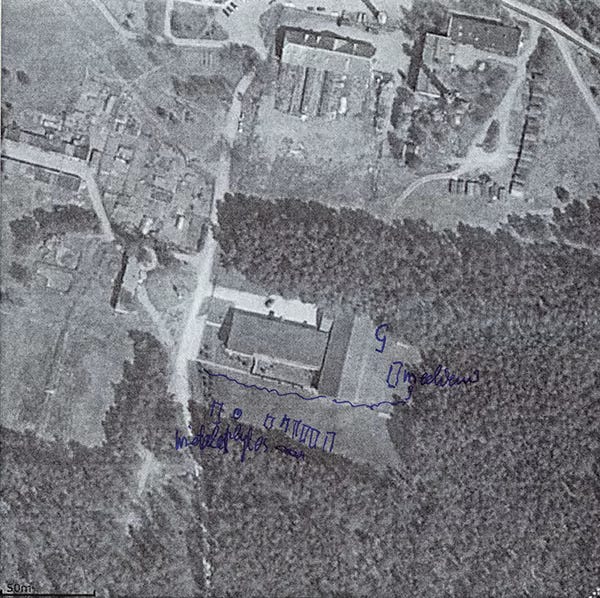
Program Continuity
Documented operations through 2005
September 17, 2001 presidential directive remains classified
Limited public disclosure of post-2006 activities
Compartmentalized information access continues under GREYSTONE classification
Legal Proceedings
Multiple ongoing international cases
State responsibility claims in various jurisdictions
Individual compensation proceedings
Continued invocation of state secrets privilege
Operational Legacy
Established precedent for extrajudicial detention systems
International cooperation frameworks for intelligence operations
Demonstration of circumvention capabilities for legal constraints
Template for compartmentalized covert programs



CONCLUSION
Extraordinary rendition operations represent a systematic, multi-national intelligence program demonstrating extensive operational capabilities, international cooperation, and legal framework circumvention. Documentation indicates significant resource allocation, institutional commitment, and strategic prioritization across multiple government agencies and foreign partners. The program's scope, scale, and documented outcomes provide comprehensive insight into extrajudicial detention and interrogation capabilities and methodologies employed in contemporary intelligence operations.

